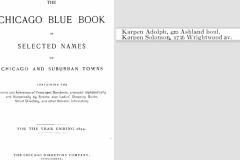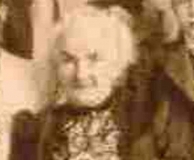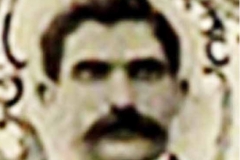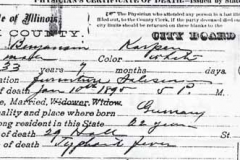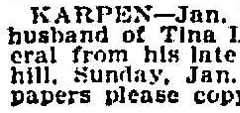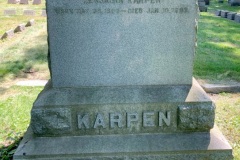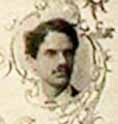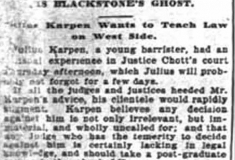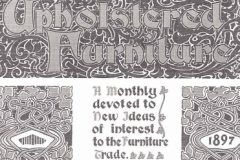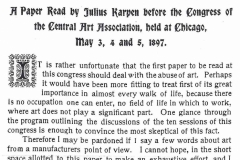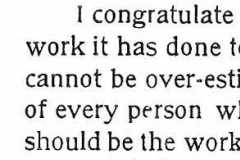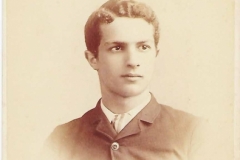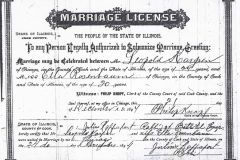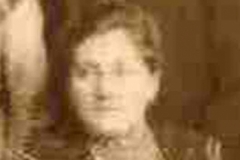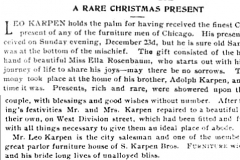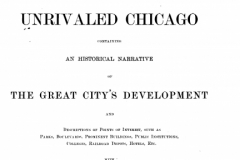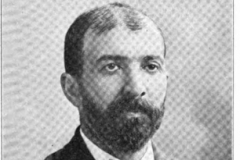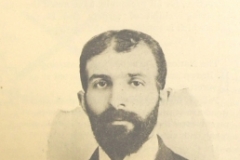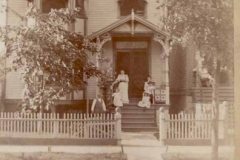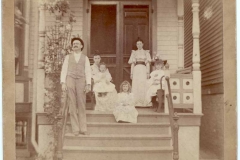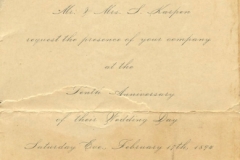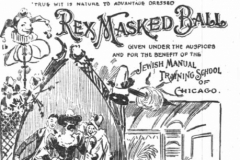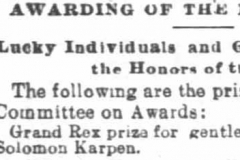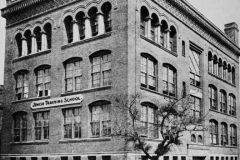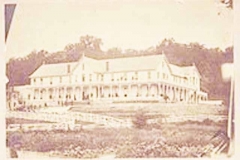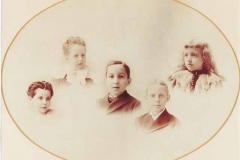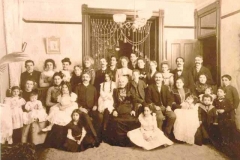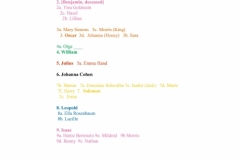The Karpen Family: 1893-1901
In the 1890s the Karpen brothers rose from struggling young immigrants to members of Chicago’s growing upper middle class. In 1894, Solomon and Adolph were first listed in the Chicago Blue Book of Selected Names of Chicago that was the address book of “prominent residents” and major associations. Each year thereafter they and the other brothers were included. Johanna Cohen Karpen (b. 1835), now in her sixties was still very much the family matriarch. All her sons lived with her or near her in the Near North Side of Chicago. Family stories passed down attest to her position. Solomon’s wife Ernestine, known as a formidable woman, was scared of her.[1] One anecdote tells how she would sit amongst her grandchildren and eat a box of chocolates—without offering even one piece to the children.[2] Another story recounts that when Isaac’s wife Hattie was cooking a big dinner, Johanna’s horse carriage pulled up to the house. Everyone yelled “put the ham away [because it was not kosher]; here comes Grandma Johanna!”[3]
A Tragic Death
The family suffered an unexpected tragedy in 1896. Benjamin (b. 1862), worked as a traveling salesman in the western states and had “a host of friends in the trade.”[4] He was included in the 1895 Chicago Blue Book. He and his wife of six years Tina Goldstein Karpen had two daughters. In the 1890s, typhoid fever was epidemic. At the end of 1895 Benjamin became infected with typhoid fever. He could have contracted the disease from contaminated water during his travels or even in Chicago. He suffered for 25 days and died on January 10, 1896. Benjamin was laid to rest in the Jewish section of Rosehill Cemetery, 5800 N. Ravenswood, Chicago. He was the first Karpen to be buried there; the earliest Jewish burials were in the 1860s. Isaac’s son, Benjamin born in 1897, carried on his uncle’s honored name.The American-Born Brother
The family matriarch must have been very proud when her only American-born son Julius (b.1873), graduated from Kent Law School in Chicago in 1896. One could imagine that this had been the family plan from their early years in America, and they must have made financial sacrifices to support Julius’ education. The eighty-seven law students in the fourth graduating class at Kent Law School elected him class president.[5] After being admitted to the Illinois Bar, [6] Julius spent three months in the West Indies before joining his brothers in the business full-time.[7]Julius married his high school (Northwest Division High School) classmate Emma May [Mae] Hand in 1898.[8] Emma was born in Chicago in 1874 to parents who had emigrated from England; her father was a blacksmith.[9] She was a Christian and taught school. The couple lived at 1842 Aldine Ave; William lived there as well. [10]
A newspaper article from 1897 indicated that Julius had plans to teach law on the West Side of Chicago. The article depicted a very confident and defiant young lawyer:
Julius most certainly could have had a career as a lawyer in a law firm, but he entered the family business and took on an important role. Although he had worked under William for several years in the office accounting department, he immediately broadened his responsibilities to legal and financial affairs. As the most educated Karpen, Julius took on a more public role than any of the other brothers except Adolph.Just after Julius started to work fulltime, he was asked to address the Congress of the Central Art Association, a three-day event held at the Art Institute, Chicago in May 1897.[11] His speech was entitled “The Abuse of Art in Manufacture,” and its full text was featured in a Karpen Bros. publication:
At the end of 1894, Leopold (b. 1870), married Ella Rosenbaum, age 20. They were married by Rabbi Julius Rappaport of Beth-El Congregation, Chicago.[12] After a festive celebration at Adolph’s home, the couple settled into their house on the Near North Side. [13] Leo was included in the Chicago Blue Book in 1897 and subsequent years.[14]
Adolph’s activities increased his prestige in Chicago.
Adolph was further honored by a profile in the trade journal, The Furniture World, which closed on this positive personal note:Mr. Karpen is widely known in business circles, and is prominently identified with many social and religious organizations. He is a member of the Chicago Athletic Association, and also a Mason in high standing. He is a man of strong personality, quick, active and honorable in all his business dealers. His range of knowledge covers a wide scope, and few men in commercial life can boast of greater versatility.[15]
Solomon (Sam) (b. 1858) and his family moved to a new house at 1736 Wrightwood Ave. on the Near North Side. There they celebrated Solomon’s 36th birthday with a surprise party in January 1894. His brothers gave him “a costly diamond ring”[16] The next month they “tendered an informal reception to their friends at their residence, No. 1736 Wrightwood Ave., last Saturday evening Feb. 17, the occasion being their tenth anniversary.” [17]
Religious and Social Groups
All the brothers were involved in various civic, fraternal, Jewish, and athletic organizations. Information gathered from furniture journals, newspaper articles, and obituaries provide a broad picture of their affiliations.
Solomon
Solomon was involved with several Jewish organizations. He was a member of the Ramah Lodge of B’nai B’rith (Sons of the Covenant) the largest Jewish fraternal organization. He was a member of the Ideal Club, a social club affiliated with the North Chicago Hebrew Congregation (later Temple Sholom) on the Near North Side.[18] The club hosted social and educational events, and weddings were held in its social hall.
Non-sectarian fraternal affiliations were important and life-long for Solomon. He was a member of the Royal League, Star Council No. 31 (Chicago) that was founded in 1883.[19] He belonged to Masonic Hesperia Lodge # 411 (Chicago) of the A.F. & A. M. (Ancient Free and Accepted Masons) as did Mike, and to the Keystone Lodge. With Mike, he was a member of B.P.O.E. (Benevolent and Protective Order of Elks).
Oscar
Oscar (b. 1859) was a member of the Illinois National Guard. He was elected 2nd lieutenant, National Guard, Third Brigade,[20] and then was a lieutenant in First Brigade.[21] He then resigned as 1st Lieutenant, A Company, Troop.[22]
Oscar was included in the Chicago Blue Book.[23] In 1900, he donated $100 the Associated Jewish Charities (Chicago).
Adolph
Adolph joined many influential organizations: associate member of German Press Club;[24] annual member of Art Institute of Chicago;[25] and a masonic lodge.[26] He was a member of the Chicago Athletic Association, which he also used for business purposes.[27] One furniture journal writer wrote: “Adolph Karpen, of Chicago, is a most entertaining host. The writer spent an evening recently as his guest at the palatial club house of the Chicago Athletic Association. A number of furniture men are members of this club and patrons of the sports.”[28]
In 1900, he donated $100 the Associated Jewish Charities (Chicago) and was a member of B’nai B’rith.
Adolph and Eugenia, the former Swedish opera singer, were part of the Chicago social scene. They attended events that were sponsored by Christian and Jewish organizations. Eugenia’s formal attire was described in the detailed local newspaper articles:
-
- Eighth Annual Knights Templar New Year’s Eve Ball which raised $10,000 for the Masonic Orphan Asylum; Jennie wore “light blue silk, trimmed in pearls and lace.”[29]
- 1st German-American Charity Ball. [30] Adolph was a patron of German-American Charity Association Ball. [other names on list: Mandel, Loeb, Rosenbaum, plus Christians.][31] Mrs. A- silk dress and diamonds. [32]
- Young Men’s Hebrew Charity Association Ball. Mrs. A. Karpen wore “silk and diamonds.[33]
- Hebrew Fete which raised $106,000 for Hebrew Charity Association and Young Men’s Hebrew Charity Association charity via bazaar and ball at the Auditorium. “Mrs. A. Karpen: Black velvet with train, panels of white and gold embroidery; jeweled girdle and violets.”[34]
- 3,000 prominent German-Americans (Jewish and Christian) of the city attended the German-American Association dance that raised funds for the Michael Reese Hospital, the Alexian Brothers’ Hospital, and the German Old People’s Home. [35] Mrs. Adolph Karpen wore “pink satin, with silver net overdress.”[36]
Isaac (Ike) Karpen
Isaac (b. 1865) was involved with non-sectarian fraternal organizations. He was a member of the Independent Order of Foresters at Battery D and served on a committee.[37] He was the Chancellor Commander, Grand Lodge (Standard Lodge No. 196), of the Knights of Pythias (K.P. or K of P.) that was founded in 1890 and had more than 260 members by 1895.[38]
He was a member of the B’nai B’rith Ramah Lodge.
Mike Karpen
Mike (b. 1866) was member of several freemason organizations. He was a Noble in the A.A.O.N.M.S. (Ancient Arabic Order of Nobles of the Mystic Shrine) in the Medinah Temple (Chicago). As was Solomon, he was a 32nd Degree Freemason in the Hesperia Lodge # 411 (Chicago) of the A.F. & A. M. (Ancient Free and Accepted Masons). He received the Ancient and Accepted Scottish Rite (A.A.S.R) degree in Valley of Chicago Consistory.
Leo Karpen
Leo enjoyed athletics. He served as captain and was on the board of directors of the Wicker Park Cycling club.[39] He continued to play baseball on the Karpen Bros. company team and with other teams.
Julius Karpen
Julius was very involved in the freemasons.
Fraternal Organizations
A family story relates the importance of fraternal organizations in that era. Mike was trying to get a big order from the Catholic Knights of Columbus. As a proud freemason he wore a big Shriner pin on his lapel. One of the salesmen who was waiting with him said, “you know you ought to take that Shriner pin off if you are going in there. They’ll never give you the order if they know you are a Mason.” Mike was a very stubborn person and stood for principles. He said, “well if they don’t like the fact that I’m a Shriner, then I don’t want the order.” He went into the office wearing his pin. In the meeting it was said: “You know the fact that you did not take your Shriner pin off proves to us that you are an honest person because we knew that you were a Shriner.”[40]
Karpen Wives
Ernestine and probably the wives of several of the others brothers were members of Jochannah (later Johanna) Lodge No. 9 of the United Order of True Sisters (U.O.T.S), a Jewish women’s organization.[41]
In 1895, S. Karpen & Bros. donated an “all Turkish leather covered gentleman’s library chair” as a prize at a masquerade ball to support the Jewish Manual Training School of Chicago by raising $8,500. The Jewish Manual Training School, supported by the Ramah and Jochannah Lodges, served all religious groups. “Sam Karpen, who appeared as Queen Lil, carried off the first prize, which was a magnificent loving cup of solid silver valued at $650.”[42]
Family Connections
Relatives of the brothers’ wives worked in the business. Julius’ brother-in-law, George Hand, was a salesman for several decades starting in the 1890s.[43] Mike’s brother-in-law, Albert Kuffer, was a salesman as well.[44] Solomon’s sister-in-law, Annie Schwalbe (b. 1867), in 1896 married Alexander Fish (b. 1868, Fisch, Chicago). Alex had been a company salesman since 1892, and his brother, S.C. Fish, had been a top Karpen salesman for many years.[45] The brothers were the sons of David Fish (Fisch) who owned the Chicago furniture store, L. Fish & Co. Alex and Sigmund C. Fish were included in the 1897 Chicago Blue Book.[46] Solomon’s other sister-in-law, Minnie Schwalbe (b. 1868) in 1887 married Louis Kahn (b. 1859, Illinois). Louis Kahn worked various low-level jobs in the factory for decades; few people knew of his connection to the Karpens.[47]
Family Vacations
With their increased financial status, the brothers, and their wives and children, were able to escape the heat of Chicago in the summers. They vacationed at the lake resort hotels around Chicago in the 1890s. Their comings and goings were reported in the Chicago newspapers and furniture trade journals.[48]
Mrs. A. [Eugenia] Karpen and Mrs. S. [Ernestine] Karpen vacationed at the French Lick Springs Hotel in French Lick, Indiana.[49]Antioch, Illinois with its chain of lakes became a resort for Chicagoans after the railroad reached there in the 1880s. Julius Karpen and his family vacationed on Lake Marie there.[50] “A coffee for Mrs. Gersen, Mrs. Mitchell, Mrs. S. Fish [wife of a Karpen Bros. salesman and sister-in-law of Mrs. Alex Fish] and Mrs. Alex Fish [Ernestine Schwalbe Karpen’s sister, Annie, who was married to a Karpen Bros. salesman] of Chicago was given at the Karpen cottage on Lake Marie. [51] And “a string of beautiful black bass, including a four-pounder, was caught by S. Karpen in Lake Marie.[52]
Delavan Lake was a small community near Lake Geneva, Wisconsin. “Mrs. S.[Ernestine] Karpen and family, 1736 Wrightwood Ave, have returned from Delavan Lake.”[53]
Colorado was the vacation destination of Adolph.[54]
The Next Generation
The Karpen brothers in the 1880s and 1890s added to their families. Solomon and Ernestine had three sons and two daughters. Oscar and Mary’s family was composed of a boy and two girls. Tina, Benjamin’s widow, brought up two daughters. Isaac and Hattie had an infant boy who died, three boys, and one girl. Mike and Ida’s infant boy died about the same time as Isaac’s son; they then had two girls. Leo and Ella had one daughter. Julius and Emma’s infant died, and they did not have more children. Adolph and Eugenia did not have any children. William (b. 1867), who was with Olga around 1901, and later married Dorinda Ferguson, had no children. To care for their households, some of the families had housekeepers and “servants” who were born in America or Ireland.[55]
The family posed for a formal photograph at Chanukah, 1901. Only Adolph and his wife Eugenia were not in attendance.
- Solomon’s daughter, Marie Karpen Berliss, as told to Ruth Berliss Ciner. (Interview with Emily C. Rose, 1993.) ↑
- Ernestine Karpen (Solomon’s wife) as told to her grandson, Jim Goldsmith. (Interview with Emily C. Rose, 1991.) ↑
- Son of Isaac Karpen, Nathan Karpen as told to his daughter, Caryl Karpen Gross. Interview with Emily C. Rose, 2001. ↑
- American Cabinet Maker and Upholsterer, June 24, 1899, 12. ↑
- Chicago Daily Tribune, Dec. 4, 1894, 5. The Illio, Vol. 1, 42. Daily Inter Ocean (Chicago), May 29, 1896. ↑
- “Julius Karpen Obituary,” Grand Rapids Furniture Record, April 1907, 627. ↑
- American Cabinet Maker and Upholsterer, May 9, 1896, 19. ↑
- Public Schools of the City of Chicago, 1892, Chicago, 1893, 260. John Leonard, ed., Book of Chicagoans: A Biographical Dictionary of Leading Living Men of the City of Chicago, (Chicago: Marquis & Co., 1905), 322-3. ↑
- Emma May Karpen, Death Certificate #3316, State of Illinois, Feb. 1, 1961. 1880, 1900, 1930 US Census, Chicago. ↑
- Lakeside Chicago City Directory 1898, 957. ↑
- S. Karpen & Bros., Upholstered Furniture 2 (June 1897), [3-4]. The Henry Ford. ↑
- Leopold Karpen and Ella Rosenbaum: Marriage License, # 227381, 1894; Illinois State Marriage Index. ↑
- Furniture, Jan. 1895, 19. ↑
- Chicago Blue Book, 1897, 591; 1898, 570; 1901, 554. ↑
- Furniture World, Apr. 16, 1896, 20. ↑
- Daily Inter Ocean (Chicago), Jan. 14, 1894. ↑
- Daily Inter Ocean (Chicago), Feb. 25, 1894. ↑
- Chicago Blue Book, 1901, 393. Hyman L. Meites, ed. History of the Jews of Chicago.1990 [1924], 149. ↑
- Daily Inter Ocean (Chicago), July 29, 1897. ↑
- Daily Inter Ocean (Chicago), Nov. 21 1893. ↑
- Daily Inter Ocean (Chicago), Jan. 13, 1895. ↑
- Biennial Report of the Adjutant General of Illinois To the Governor and Commander-In-Chief, 1895 and 1896. (Springfield, IL, 1897). ↑
- Chicago Blue Book, 1897, 591; 1898, 570; 1901, 554. ↑
- Daily Inter Ocean (Chicago), Feb. 26, 1893. ↑
- The Art Institute of Chicago, 16th Annual Report, 1895. ↑
- Furniture World, Apr. 16, 1896, 20. ↑
- Chicago Blue Book, 1894, 358; 1895, 393; 1901, 354. ↑
- Furniture World, Apr. 16, 1896, 20. The Furniture World, May 23, 1895, 17. ↑
- Chicago Daily Tribune, Jan. 2. 1894. ↑
- Chicago Daily Tribune, Jan. 25, 1895. ↑
- Chicago Daily Tribune, Dec. 15, 1895. ↑
- Daily Inter Ocean (Chicago), Dec 16, 1895. Daily Inter Ocean (Chicago), Jan. 5, 1896; Jan. 22, 1896. ↑
- Daily Inter Ocean (Chicago), Dec. 16, 1896. ↑
- Chicago Daily Tribune, Dec. 8, 1898. ↑
- Chicago Daily Tribune, Dec.19, 1899. ↑
- Chicago Daily Tribune, Dec. 19, 1899. ↑
- Chicago Daily Tribune, Jan. 1, 1893. ↑
- Daily Inter Ocean (Chicago), Apr.30, 1895. ↑
- Chicago Daily Tribune, Mar. 16, 1894. ↑
- Bill Winberg (grandson of Mike Karpen) interview with Emily C. Rose, 1998. ↑
- Cornelia Wilhelm, The Independent Orders of B’nai B’rith and True Sisters: Pioneers of a New Jewish Identity, 1843-1914. Detroit: Wayne State University Press, 2011. Cornelia Wilhelm, “The Independent Order of True Sisters: Friendship, Fraternity, and a Model of Modernity for Nineteenth-Century American Jewish Womanhood,” American Jewish Archives Journal, Vol. 54 No. 1, 2002, 37-63. ↑
- Chicago Daily Tribune, Mar. 31, 1895. Furniture World, Apr. 4, 1895, 31. ↑
- The Furniture Journal, Oct. 18,1934, 19. ↑
- The Furniture Journal, Dec. 25, 1901, 21-2. ↑
- Furniture (Chicago), Jan. 1892, 52. ↑
- Chicago Blue Book, 1897, 544. ↑
- US Census 1900. Interviews, Claire Nosek (secretary 1934-1951, S. Karpen & Bros.), with Emily C. Rose, 1994; Ruth Berliss and Arthur D. Berliss, with Emily C. Rose, 1998. ↑
- Chicago Daily Tribune, Aug. 28, 1892. Chicago Daily Tribune, July 24, 1892. ↑
- Chicago Daily Tribune, May 5, 1895. ↑
- Chicago Daily Tribune, Aug. 2, 1895. Daily Inter Ocean (Chicago), Aug. 9, 1896. ↑
- Daily Inter Ocean (Chicago), Aug. 16, 1896. ↑
- Daily Inter Ocean (Chicago), Aug. 16, 1896. ↑
- Chicago Daily Tribune, Sept. 7, 1897. ↑
- American Cabinet Maker and Upholsterer, June 9, 1894, 16. ↑
- 1900 US Census: Solomon, Oscar, Isaac, Leo Karpen. ↑
